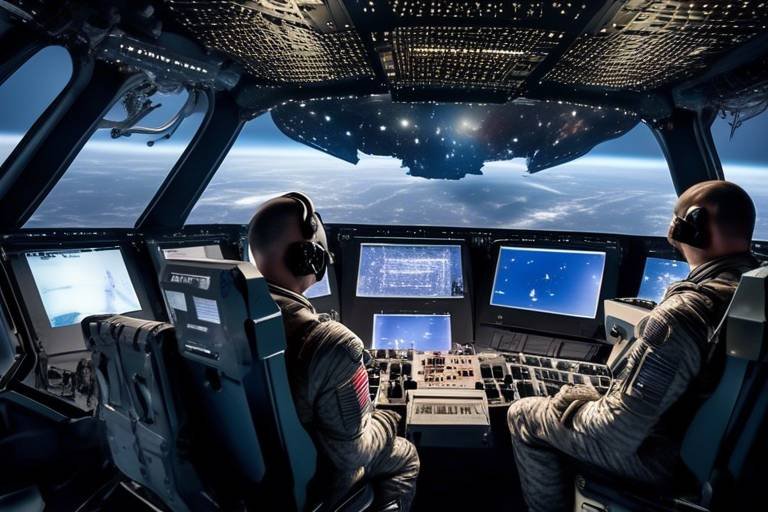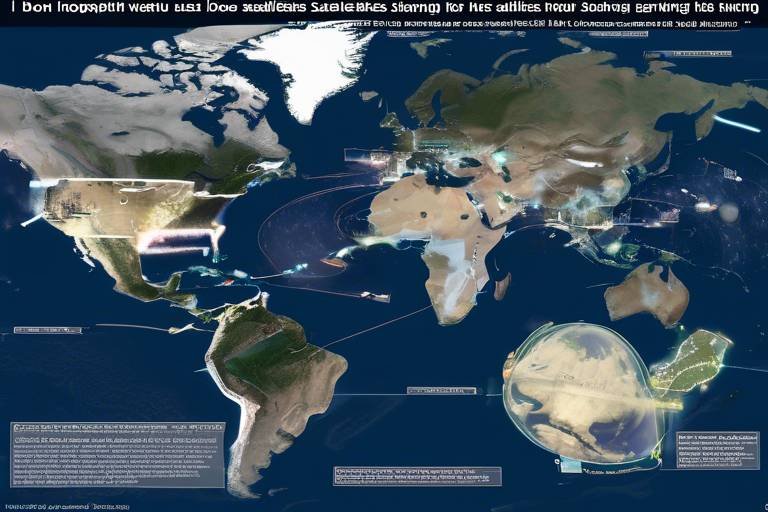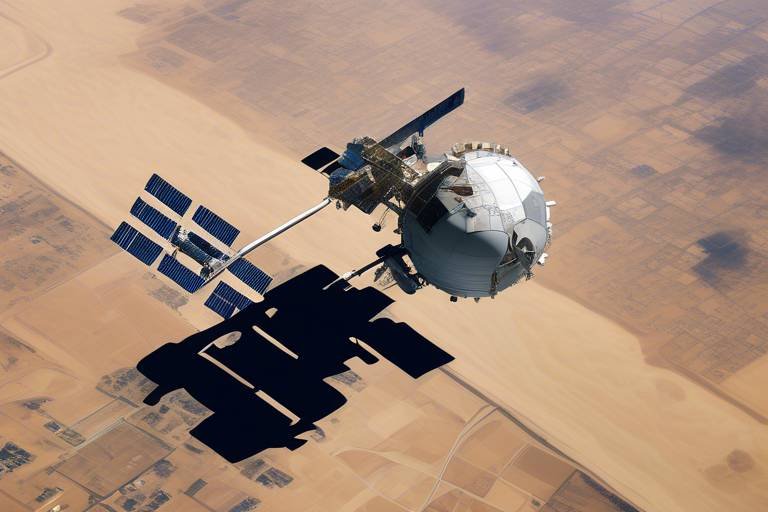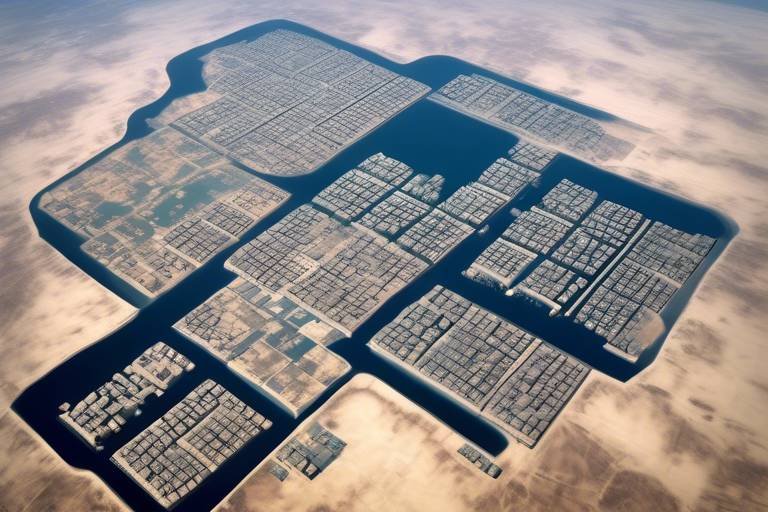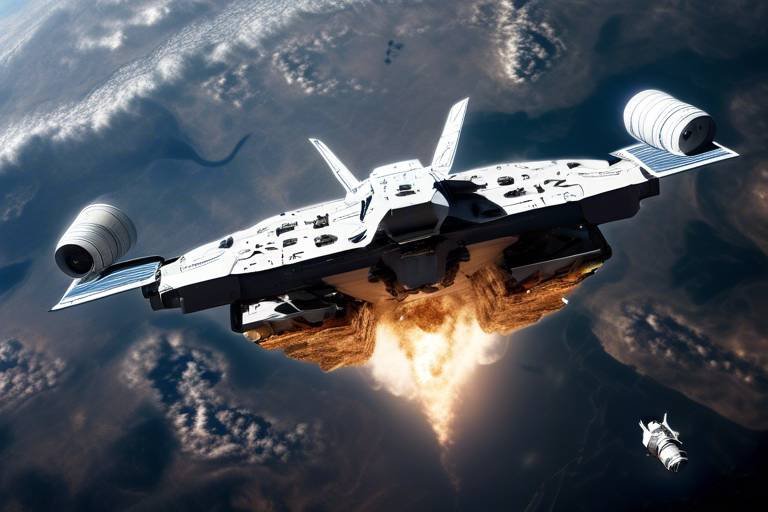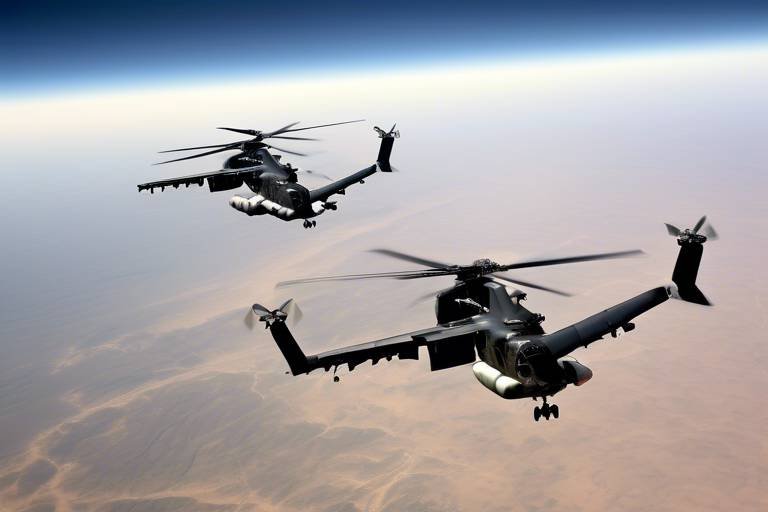The Strategic Importance of Space Situational Awareness
In an era where our reliance on technology is at an all-time high, the concept of Space Situational Awareness (SSA) has emerged as a cornerstone of national security and commercial viability. But what exactly does this mean? Simply put, SSA is the ability to detect, track, and predict the movement of objects in space, as well as assess the environment for potential threats. As we venture deeper into the cosmos, the stakes are higher than ever, making SSA not just important, but absolutely critical for safeguarding our assets and interests beyond Earth.
Imagine the vastness of space as a bustling city, where every satellite is a car navigating through busy streets. Just as traffic lights and road signs keep vehicles safe, SSA provides the necessary information to prevent collisions and ensure smooth operations. With the increasing number of satellites—both governmental and commercial—crowding the orbital highways, the risk of accidents and debris collisions has skyrocketed. The implications of a single collision can be catastrophic, not just for the involved parties but for the entire space ecosystem.
Moreover, SSA plays a pivotal role in international cooperation. Countries around the globe are recognizing that space is not just an extension of their territory but a shared domain that requires collaborative efforts to maintain safety and security. By pooling resources and sharing data, nations can develop comprehensive strategies to tackle challenges such as space debris and potential threats from adversarial entities. This cooperation is akin to neighbors working together to maintain a clean and safe community, highlighting the importance of unity in the face of shared risks.
As we delve deeper into this topic, it becomes evident that the strategic importance of SSA extends beyond mere tracking and monitoring. It encompasses a wide array of functions that contribute to national defense, commercial operations, and international diplomacy. With each passing day, the need for effective SSA becomes increasingly urgent, urging us to invest in technologies and partnerships that will ensure a secure and sustainable future in space.
- What is Space Situational Awareness?
SSA refers to the ability to detect, track, and predict the movement of objects in space, as well as assess the space environment for potential threats. - Why is SSA important for national security?
SSA is vital for military operations to maintain space superiority, protect critical assets, and ensure effective responses to potential threats posed by adversaries in space. - How does space debris impact SSA?
Space debris poses significant risks to operational satellites, making effective SSA essential for tracking debris and predicting collision risks. - What role does international cooperation play in SSA?
Collaboration among nations enhances SSA capabilities, allowing for shared data and joint strategies to address common challenges.
The Definition of Space Situational Awareness
Space Situational Awareness (SSA) is a term that encapsulates a wide range of activities and technologies aimed at understanding the space environment and the objects within it. At its core, SSA involves the continuous monitoring of objects in space, which includes everything from operational satellites to defunct spacecraft and space debris. Imagine trying to navigate through a crowded room filled with people, where some are moving quickly and others are stationary; this is akin to how SSA operates in the vast expanse of space. It’s not just about knowing what’s out there; it’s about predicting what could happen next.
One of the critical components of SSA is the ability to predict potential collisions between objects in space. This predictive capability is essential for ensuring the safety of satellites, as even a tiny piece of debris traveling at high speeds can cause catastrophic damage. For instance, the infamous 2009 collision between an Iridium satellite and a defunct Russian satellite serves as a stark reminder of the dangers present in an increasingly congested orbital environment. Through advanced tracking systems and data analysis, SSA enables operators to assess risks and implement collision avoidance strategies.
Moreover, SSA also involves assessing the space environment for various threats that could impact satellites and other assets. These threats can range from natural phenomena, such as solar flares and radiation storms, to intentional acts by adversaries seeking to disrupt or destroy space-based capabilities. Thus, SSA is not merely a technical endeavor; it is a critical element of national security and commercial viability, allowing stakeholders to make informed decisions based on a comprehensive understanding of the operational landscape.
In summary, SSA is a multifaceted discipline that combines technology, data analysis, and strategic foresight. It is essential for maintaining the integrity of space operations, protecting valuable assets, and ensuring the sustainability of activities in the final frontier. As we move towards a future where space is more accessible, the importance of effective SSA will only continue to grow, making it a cornerstone of both national and commercial space strategies.
The Role of SSA in National Security
When we talk about Space Situational Awareness (SSA), it’s not just about keeping an eye on twinkling stars or orbiting satellites; it’s a matter of national security. Imagine a chess game where every piece represents a satellite or space asset. Just like in chess, knowing your opponent's moves is crucial to winning the game. SSA provides the intelligence needed to navigate the complex and often dangerous space environment, ensuring that nations can maintain their strategic advantage.
In today’s world, where space is becoming increasingly crowded, the importance of SSA in national defense strategies cannot be overstated. It enables military operations to maintain space superiority, which is vital for protecting critical assets such as communication satellites and GPS systems. These assets are not just technological marvels; they are lifelines for military operations, emergency services, and even our daily lives. Without effective SSA, nations risk falling behind in the ever-evolving landscape of space warfare.
Furthermore, SSA plays a crucial role in assessing potential threats posed by adversaries. In a realm where satellites can be used for surveillance, intelligence gathering, and even offensive capabilities, understanding the capabilities and intentions of other nations is essential. This is where the monitoring of objects in space comes into play. By tracking both friendly and adversarial satellites, nations can develop strategies that enhance their security and readiness.
One of the most pressing challenges that SSA addresses is the issue of space debris. With thousands of defunct satellites and fragments from collisions littering the orbits, the risk to operational satellites is significant. Imagine driving on a highway filled with obstacles; that’s what navigating space has become. Effective SSA is essential for tracking this debris, predicting potential collision risks, and implementing mitigation strategies. This ensures that valuable space assets are safeguarded, allowing for uninterrupted services that are critical for national security.
To minimize the risk of satellite damage, implementing collision avoidance measures based on SSA data is imperative. These strategies rely on real-time data analysis and predictive modeling to navigate the treacherous landscape of space debris. By leveraging SSA, military and commercial satellites can adjust their trajectories to avoid potential collisions, ensuring the continued functionality of essential services such as communication and navigation. The ability to proactively manage these risks is akin to having a navigation system that alerts you to upcoming roadblocks before you encounter them.
In an era where space is becoming a contested domain, international cooperation is crucial for enhancing SSA capabilities. No single nation can effectively monitor and manage the complexities of space alone. Collaboration among nations allows for the sharing of vital data and the development of joint strategies to address shared challenges, including space debris and potential threats from hostile entities. This cooperative approach not only strengthens national security but also promotes a more stable and sustainable space environment for all.
In conclusion, SSA is not merely a technical requirement; it is a strategic necessity for national security. As nations continue to rely more heavily on space assets, the need for robust SSA systems will only grow. By prioritizing SSA, countries can enhance their military readiness, protect vital space assets, and ensure that they remain competitive in the global arena.
- What is Space Situational Awareness? - SSA refers to the ability to detect, track, and predict the movement of objects in space to ensure the safety and security of space operations.
- Why is SSA important for national security? - It enables military operations to maintain space superiority and protects critical assets from potential threats, including space debris and adversarial actions.
- How does space debris impact satellites? - Space debris poses a collision risk to operational satellites, which can lead to loss of functionality and disruption of essential services.
- What role does international cooperation play in SSA? - Collaboration among nations enhances SSA capabilities, allowing for shared data and joint strategies to address common challenges in space.
The Impact of Space Debris
Space debris, often referred to as space junk, is one of the most pressing challenges facing our increasingly congested orbits. With thousands of defunct satellites, spent rocket stages, and fragments from collisions, the risk to operational spacecraft is growing exponentially. Imagine driving on a highway filled with obstacles, where every vehicle represents an active satellite and every piece of debris is a potential hazard. This scenario is not far from reality in the vast expanse of space, where even a small piece of debris can cause catastrophic damage at incredible speeds.
The impact of space debris on satellites and other assets in orbit is profound. For instance, the risk of collision increases significantly as the number of objects in space rises. A collision can lead to a cascade effect, where one collision generates more debris, which in turn increases the likelihood of further collisions. This phenomenon, known as the Kessler Syndrome, poses a serious threat to the long-term sustainability of space activities. According to recent estimates, there are over 34,000 pieces of debris larger than 10 cm, and millions of smaller fragments that are difficult to track but equally dangerous.
Effective space situational awareness (SSA) is essential for tracking these debris objects and predicting potential collision risks. By utilizing advanced technologies such as radar and optical sensors, space agencies and private companies can monitor the debris field and assess the potential threats to operational satellites. For example, the European Space Agency (ESA) has developed the Space Debris Office, which actively tracks and catalogs debris, providing crucial data to satellite operators to help them make informed decisions.
To mitigate the risks posed by space debris, several strategies can be implemented. These include:
- Collision Avoidance Maneuvers: Satellites can be repositioned to avoid potential collisions based on SSA data.
- Debris Removal Technologies: Innovative solutions, such as robotic arms and nets, are being developed to actively remove large debris from orbit.
- Design for Demise: New satellites are being designed to burn up upon re-entry, reducing the amount of debris created.
In conclusion, the impact of space debris is a multifaceted problem that requires immediate attention and action. As we continue to expand our presence in space, the importance of effective SSA cannot be overstated. It is not just about protecting our current assets; it is about ensuring the future of space exploration and utilization. The collaboration between nations, private companies, and international organizations will be critical in developing comprehensive strategies to address this growing threat. The future of our activities in space hinges on our ability to manage and mitigate the risks associated with space debris effectively.
Collision Avoidance Strategies
In the vast expanse of space, where countless satellites and debris coexist, the risk of collisions is a pressing concern. To mitigate these risks, are not just beneficial; they are essential. These strategies leverage data gathered through Space Situational Awareness (SSA) to predict potential collisions and implement proactive measures to protect valuable space assets. Imagine navigating a busy highway without traffic signals or lanes; that’s what space looks like without effective collision avoidance strategies!
One of the primary methods for collision avoidance involves the use of conjunction analysis. This process assesses the trajectories of objects in space to identify potential close approaches, or conjunctions. Once a potential collision is detected, operators can take actions such as adjusting the orbit of a satellite to avoid the debris. This is akin to swerving your car to avoid a sudden obstacle on the road.
Moreover, the integration of advanced technologies plays a pivotal role in enhancing collision avoidance strategies. For instance, using automated maneuvering systems allows satellites to autonomously adjust their orbits in response to collision threats. This technology not only reduces the response time but also minimizes human error, which can be critical in high-stakes scenarios.
To further illustrate the importance of these strategies, consider the following table that outlines the key collision avoidance measures:
| Collision Avoidance Measure | Description | Benefits |
|---|---|---|
| Conjunction Analysis | Identifying potential close approaches between objects | Early detection of collision risks |
| Automated Maneuvering | Autonomous adjustment of orbits to avoid collisions | Reduced response time and human error |
| Data Sharing | Collaboration between agencies to share SSA data | Comprehensive understanding of the space environment |
Additionally, data sharing between countries and organizations is crucial for effective collision avoidance. When various space-faring entities collaborate and share their SSA data, it creates a more comprehensive picture of the space environment. This collective approach can significantly enhance the accuracy of conjunction analyses and lead to more informed decision-making.
In conclusion, collision avoidance strategies are vital for maintaining the safety and functionality of satellites in an increasingly crowded space. By employing a combination of conjunction analysis, automated systems, and international cooperation, we can navigate the complexities of space with greater confidence. After all, in the realm of space, a proactive approach can be the difference between a successful mission and a catastrophic failure.
International Cooperation in SSA
The complexity of space situational awareness (SSA) necessitates an unprecedented level of international cooperation. As nations launch more satellites and engage in various activities in space, the need for collaboration becomes not just beneficial but essential. Imagine a bustling city where everyone is driving without traffic lights; chaos would ensue. In the same way, space is becoming increasingly crowded, and without collaborative efforts, the risk of collisions and misunderstandings escalates dramatically. Countries must come together to share information, resources, and strategies to effectively manage the space environment.
One of the most significant outcomes of international cooperation in SSA is the sharing of data. Countries like the United States have initiated programs to provide satellite tracking data to other nations, enhancing global awareness of potential threats and risks. This type of transparency is crucial, as it allows nations to make informed decisions regarding their space assets. For instance, when a piece of debris is detected, having a comprehensive database that includes contributions from multiple countries can significantly improve the accuracy of collision predictions.
Furthermore, international partnerships can lead to the development of joint strategies for addressing shared challenges, such as space debris. The European Space Agency (ESA) and NASA have engaged in collaborative efforts to devise mitigation strategies that reduce the creation of new debris. Such initiatives not only protect national assets but also promote a sense of global responsibility towards preserving the space environment for future generations.
In addition to formal agreements, informal networks and forums also play a vital role in fostering cooperation. For example, the Inter-Agency Space Debris Coordination Committee (IADC) is a platform where space agencies from around the world come together to discuss best practices and share knowledge regarding debris mitigation. These discussions can lead to the establishment of common guidelines that all nations can adopt, thereby enhancing the overall safety of space operations.
The benefits of international cooperation extend beyond mere safety; they also encompass economic and technological advancements. By pooling resources, nations can invest in cutting-edge technologies that enhance SSA capabilities. For example, collaborative research initiatives can lead to the development of sophisticated sensors and tracking systems that no single nation might afford to create independently. This synergy not only bolsters national security but also stimulates innovation within the commercial space sector.
In summary, the path to effective space situational awareness is paved with collaboration. As we navigate the complexities of an ever-evolving space landscape, international cooperation will be the key to ensuring that all nations can safely and sustainably explore the final frontier. The stakes are high, and the time for united efforts is now, as the future of space depends on our ability to work together.
- What is Space Situational Awareness (SSA)?
SSA refers to the ability to detect, track, and predict the movement of objects in space, as well as assess potential threats to satellites and other space assets. - Why is international cooperation important for SSA?
International cooperation enhances data sharing, improves collision predictions, and fosters the development of joint strategies to tackle challenges like space debris. - How does space debris affect satellites?
Space debris poses a significant risk to operational satellites, potentially leading to collisions that can damage or destroy these valuable assets. - What role does technology play in improving SSA?
Technological advancements, including AI and improved sensors, greatly enhance SSA capabilities, allowing for more accurate tracking and better predictions of space events.
The Commercial Implications of SSA
In today's rapidly evolving space landscape, the concept of Space Situational Awareness (SSA) is not just a military concern; it has profound implications for the commercial sector as well. As more private companies venture into space, the need for robust SSA becomes critical to protect investments and ensure the safety of operations. Imagine the vastness of space as a bustling highway, where satellites are the vehicles navigating through a sea of potential hazards. Without effective SSA, these vehicles could easily collide, leading to catastrophic losses.
As commercial space activities expand, the challenges associated with SSA multiply. For instance, companies launching satellites must consider the growing population of space debris, which can threaten their assets. This debris, which includes defunct satellites and fragments from past collisions, can travel at speeds exceeding 17,500 miles per hour, making even small pieces capable of causing significant damage. Therefore, businesses must invest in SSA technologies to monitor their operational environment continuously. Here’s where the commercial implications become evident:
- Investment Protection: Companies need to safeguard their multi-million-dollar satellites from potential collisions. By utilizing SSA, they can assess risks and make informed decisions about satellite maneuvers.
- Operational Efficiency: Effective SSA allows companies to optimize satellite operations, reducing downtime and ensuring services like GPS and communication remain uninterrupted.
- Regulatory Compliance: As governments establish regulations for space traffic management, companies must adhere to these guidelines, making SSA a necessary part of their operational strategy.
Moreover, the integration of SSA into commercial practices fosters a sustainable space economy. By ensuring the safety of satellite operations, businesses can build trust with stakeholders and consumers, promoting further investment in space technologies. Just like how traffic lights and road signs help vehicles navigate safely on Earth, SSA serves as a guiding framework for satellites, ensuring they can operate without fear of collision.
Furthermore, the collaboration between commercial entities and government agencies enhances SSA capabilities. By sharing data and insights, both sectors can develop comprehensive strategies to tackle the challenges posed by space debris and other threats. This partnership is akin to a team of explorers working together to map uncharted territory; each contribution adds value to the collective understanding of the space environment.
In conclusion, the commercial implications of SSA are vast and multifaceted. As the space economy continues to grow, the integration of SSA into commercial strategies will not only protect investments and enhance operational efficiency but also pave the way for a sustainable and prosperous future in space exploration and utilization. Companies that prioritize SSA will be better positioned to navigate the complexities of this new frontier, ensuring their place in the ever-expanding universe of commercial space activities.
- What is Space Situational Awareness (SSA)?
SSA refers to the ability to detect, track, and predict the movement of objects in space, as well as assess the environment for potential threats to satellites and other space assets. - Why is SSA important for commercial space activities?
SSA is crucial for protecting investments, ensuring the safety of satellite operations, and complying with regulations, thereby fostering a sustainable space economy. - How does space debris affect commercial satellites?
Space debris poses a significant risk to operational satellites, as even small fragments can cause severe damage due to their high speeds. Effective SSA is essential for monitoring and mitigating these risks. - What role do governments play in SSA?
Governments collaborate with commercial entities to enhance SSA capabilities by sharing data and developing joint strategies to address challenges such as space debris and potential threats.
Technological Advances in SSA
In the ever-evolving realm of space, technological advances in Space Situational Awareness (SSA) are revolutionizing how we monitor and understand our surroundings beyond Earth. With the increasing number of satellites and space debris, the need for cutting-edge technologies has never been greater. These advancements not only enhance our ability to track objects in orbit but also improve our predictive capabilities, ensuring that we can respond proactively to potential threats. From sophisticated sensors to advanced data analytics, the landscape of SSA is being reshaped by innovation.
One of the most significant breakthroughs in SSA technology is the development of high-resolution satellite imaging. This technology allows for real-time monitoring of space objects, providing detailed visuals that help operators assess the status and trajectory of satellites and debris. Coupled with advanced radar systems, these imaging technologies can detect even the smallest pieces of debris, which is crucial for collision avoidance. Imagine trying to navigate a busy highway with only a vague idea of where other vehicles are; that's what space operators faced before these advancements. Now, they have a clearer picture, allowing for more informed decision-making.
Another transformative element is the integration of artificial intelligence (AI) into SSA systems. AI algorithms can process vast amounts of data in mere seconds, identifying patterns and predicting potential collisions with remarkable accuracy. This capability is akin to having a personal assistant who can sift through mountains of information and highlight the most critical details. By automating data analysis, AI not only saves time but also reduces the risk of human error, which can be catastrophic in the high-stakes environment of space.
Furthermore, the rise of cloud computing has made SSA data more accessible. With powerful cloud infrastructure, organizations can share and analyze data collaboratively, leading to a more comprehensive understanding of the space environment. This interconnectedness fosters a culture of cooperation among nations and private entities, allowing for a unified approach to tackling space challenges. Imagine a global network of experts working together, sharing insights, and developing strategies that enhance our collective safety in space.
To illustrate the impact of these technological advancements, consider the following table, which summarizes key innovations in SSA:
| Technology | Description | Impact on SSA |
|---|---|---|
| High-Resolution Imaging | Real-time visuals of space objects | Improves tracking and assessment |
| Advanced Radar Systems | Detection of small debris | Enhances collision avoidance |
| Artificial Intelligence | Automated data analysis | Reduces human error, speeds up decision-making |
| Cloud Computing | Shared data access among users | Fosters collaboration and comprehensive understanding |
As we look to the future, the ongoing development of autonomous systems will further enhance SSA capabilities. These systems can operate independently, monitoring space environments without constant human oversight. This innovation could be likened to having a fleet of drones patrolling the skies, ready to alert us to any anomalies. The combination of these technologies not only addresses current challenges but also prepares us for the complexities of an increasingly crowded space.
In conclusion, the technological advancements in SSA are not just incremental improvements; they represent a paradigm shift in how we perceive and interact with space. As these innovations continue to unfold, they will play a crucial role in ensuring the safety and sustainability of our activities beyond Earth. The future of SSA looks promising, with technology paving the way for a more secure and cooperative space environment.
- What is Space Situational Awareness? SSA refers to the ability to detect, track, and predict the movement of objects in space, including satellites and debris.
- Why is SSA important for national security? SSA is crucial for maintaining space superiority, protecting critical assets, and responding effectively to threats.
- How does AI improve SSA? AI enhances SSA by automating data analysis, identifying patterns, and making real-time predictions about space events.
- What role do international partnerships play in SSA? Collaboration among nations is essential for sharing data and developing strategies to address common challenges in space.
Artificial Intelligence in SSA
Artificial Intelligence (AI) is revolutionizing the field of Space Situational Awareness (SSA) in ways we could only dream of a few years ago. Imagine a vast expanse of space filled with thousands of satellites, space debris, and other celestial objects, all moving at incredible speeds. Monitoring this chaotic environment manually would be like trying to find a needle in a haystack, but with AI, we can now sift through the data with remarkable efficiency and accuracy. AI technologies are not just enhancing our capabilities; they are fundamentally changing how we approach the challenges of space.
One of the most significant advantages of integrating AI into SSA systems is its ability to process and analyze large datasets at lightning speed. Traditional methods of data analysis can be time-consuming and prone to human error, but AI algorithms can quickly identify patterns and anomalies in the data. This allows for real-time decision-making that is critical for maintaining space safety. For instance, AI can help predict potential collisions between satellites and debris, providing operators with the necessary information to take evasive action before a disaster strikes.
Moreover, the use of machine learning—an AI subset—enables systems to improve over time. As these systems are fed more data, they become better at predicting outcomes and recognizing potential threats. This is akin to how a seasoned pilot learns to anticipate changes in weather patterns based on years of experience. In the realm of SSA, this means that AI can help in creating a more reliable and proactive approach to space traffic management.
To illustrate the impact of AI on SSA, consider the following key applications:
- Predictive Analytics: AI can analyze historical data to forecast future space events, such as predicting when a piece of debris might intersect with a satellite's orbit.
- Autonomous Decision-Making: AI systems can make real-time decisions without human intervention, which is crucial for responding to rapidly changing situations in space.
- Data Fusion: AI can integrate data from multiple sources, including ground-based sensors and other satellites, providing a comprehensive view of the space environment.
As we look to the future, the role of AI in SSA is expected to expand even further. With advancements in deep learning and neural networks, AI systems will become even more sophisticated, enabling them to tackle increasingly complex challenges in space. The synergy between human expertise and AI capabilities will create a robust framework for ensuring the safety and security of our assets in orbit.
In conclusion, the integration of AI into Space Situational Awareness is not just a technological upgrade; it represents a paradigm shift in how we understand and manage the space environment. As we continue to explore the cosmos, the importance of AI in ensuring the safety of our satellites and the sustainability of our activities in space will only grow. By embracing these innovations, we can navigate the challenges of an increasingly congested space and secure our future among the stars.
Q: What is Space Situational Awareness (SSA)?
A: SSA refers to the ability to detect, track, and predict the movement of objects in space, as well as assess potential threats to satellites and other space assets.
Q: How does AI improve SSA?
A: AI enhances SSA by automating data analysis, improving predictive capabilities, and enabling real-time decision-making, thus making space operations safer and more efficient.
Q: Why is SSA important for national security?
A: SSA is crucial for national defense as it allows military operations to maintain space superiority and protect critical assets from potential threats, including hostile actions in space.
Q: What challenges does space debris pose?
A: Space debris can collide with operational satellites, causing damage that disrupts communication and navigation services. Effective SSA is essential for tracking debris and implementing collision avoidance strategies.
Future Trends in Space Situational Awareness
As we gaze into the horizon of space exploration and utilization, the future of Space Situational Awareness (SSA) is not just a topic of interest; it's a necessity. With the increasing number of satellites, space debris, and the potential for conflicts in space, the trends shaping SSA are more critical than ever. Imagine a bustling city with cars zooming in every direction—now, think of space as that city, where each satellite is a car, and the roads are the orbits. The need for effective traffic management becomes paramount, and this is where SSA comes into play.
One of the most significant trends is the rise of autonomous systems. These systems, powered by advanced algorithms and artificial intelligence, are being developed to monitor space environments continuously. They can analyze vast amounts of data in real-time, allowing for proactive measures against potential collisions or threats. Just like a self-driving car that can predict and react to obstacles, these autonomous systems will enhance our ability to navigate the complexities of space.
Moreover, the future of SSA will see enhanced international partnerships. As space knows no borders, collaboration among nations will be crucial. Countries are beginning to understand that sharing data and resources can lead to a more comprehensive understanding of the space environment. Imagine a global network of observatories working together, akin to a team of detectives pooling their clues to solve a mystery. By sharing information about space debris and potential threats, nations can create a safer environment for all.
Additionally, innovative tracking technologies are on the rise. The development of next-generation sensors and satellites equipped with advanced capabilities will allow for more precise tracking of objects in space. Consider this as upgrading from a basic camera to a high-definition one; the clarity and detail improve significantly, enabling better decision-making. These technologies will not only enhance our ability to monitor existing satellites but also improve our capacity to predict future threats.
Furthermore, the integration of machine learning into SSA systems is set to revolutionize the field. Machine learning algorithms can sift through historical data to identify patterns and predict future events. This is akin to a seasoned chess player who anticipates their opponent's moves based on previous games. By leveraging this technology, SSA can evolve from reactive to proactive, allowing for timely interventions and enhanced safety in space operations.
In conclusion, the future of Space Situational Awareness is bright and full of potential. With trends like autonomous systems, international cooperation, innovative tracking technologies, and machine learning, we are on the brink of a new era in space safety and management. As we continue to explore the final frontier, embracing these advancements will be crucial in ensuring that the vastness of space remains a safe and accessible domain for all.
- What is Space Situational Awareness (SSA)?
SSA refers to the ability to detect, track, and predict the movement of objects in space, ensuring the safety and security of space operations. - Why is SSA important for national security?
SSA plays a critical role in national defense by enabling military operations to maintain space superiority and protect critical assets from potential threats. - How does space debris affect satellites?
Space debris poses a significant risk to operational satellites, as even small fragments can cause catastrophic damage upon collision. - What role does international cooperation play in SSA?
Collaboration among nations enhances SSA capabilities by allowing data sharing and the development of joint strategies to address common challenges.
Frequently Asked Questions
- What is Space Situational Awareness (SSA)?
Space Situational Awareness (SSA) refers to the ability to detect, track, and predict the movement of objects in space. It encompasses monitoring satellites, space debris, and other celestial phenomena to assess potential threats and ensure the safety of space operations.
- Why is SSA important for national security?
SSA plays a crucial role in national security by enabling military forces to maintain space superiority. It helps protect critical assets from adversarial threats and ensures effective responses to potential risks, thus safeguarding national interests in the increasingly contested domain of space.
- How does space debris affect satellite operations?
Space debris poses a significant risk to operational satellites, as even small pieces can cause catastrophic damage. Effective SSA is essential for tracking this debris, predicting potential collisions, and implementing mitigation strategies to protect valuable space assets from being compromised.
- What are collision avoidance strategies?
Collision avoidance strategies involve using SSA data to predict and prevent potential collisions between satellites and space debris. These measures can include maneuvering satellites to alter their orbits, ensuring that critical services like communication and navigation remain uninterrupted.
- How do countries collaborate on SSA?
International cooperation in SSA involves sharing data, resources, and strategies among nations to enhance collective capabilities. By working together, countries can better address challenges like space debris and potential threats from hostile entities, promoting a safer space environment for all.
- What are the commercial implications of SSA?
The rise of commercial space activities highlights the need for robust SSA to protect private investments and ensure the safety of satellite operations. Effective SSA fosters a sustainable space economy, benefiting all stakeholders involved in the growing space industry.
- How have technological advances improved SSA?
Recent advancements in satellite technology, sensors, and data analytics have significantly enhanced SSA capabilities. These improvements allow for more accurate tracking of objects in space and better prediction of space events, contributing to overall situational awareness.
- What role does artificial intelligence play in SSA?
Artificial intelligence is increasingly being integrated into SSA systems to analyze large datasets, identify patterns, and make real-time decisions. This integration enhances the ability to maintain situational awareness in space, improving response times and operational effectiveness.
- What are the future trends in Space Situational Awareness?
As space becomes more congested, future trends in SSA will likely include the development of autonomous systems, enhanced international partnerships, and innovative tracking technologies. These trends will address both the challenges and opportunities presented by the evolving landscape of space operations.


